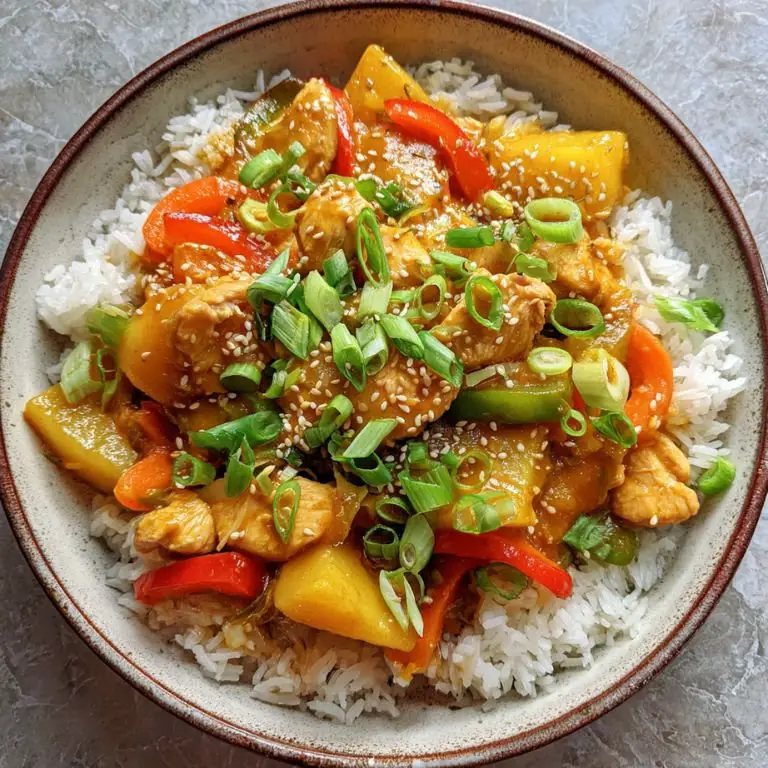There’s something deeply comforting about a bowl of curry rice, especially when it’s infused with the savory warmth of Korean spices and slow-cooked to perfection. This Slow Cooker Korean Chicken Curry with Peppers is the kind of meal that makes you look forward to dinner all day long. It’s a hybrid of familiar curry chicken recipes and bold Korean flavors, with tender chicken breast, sweet bell peppers, and a golden, mildly spicy curry sauce that simmers into something magical. Think of it as a love letter to both korean cooking and cozy slow-cooked meals—perfect for busy weeknights or lazy weekends alike.
Slow Cooker Korean Chicken Curry with Peppers
Prep Time 20 minutes mins
Cook Time 6 hours hrs
Total Time 6 hours hrs 20 minutes mins
Course Main Course
Cuisine Korean
Slow Cooker (4-6 quart) The MVP for making the chicken melt-in-your-mouth tender
Cutting board and sharp knife For prepping veggies and meat
Grater or microplane To grate the apple and ginger
Measuring cups and spoons Accuracy matters for spice balance
Small bowl For mixing the cornstarch slurry
For the Curry
- 1.5 lbs boneless skinless chicken breast (cut into large chunks)
- 1 large yellow onion sliced thin
- 3 cloves garlic minced
- 1 tablespoon fresh ginger grated
- 2 bell peppers 1 red, 1 green, sliced
- 2 medium carrots peeled and chopped
- 2 medium Yukon gold potatoes cubed
- 1 small apple Fuji or Gala, grated (adds sweetness and umami)
- 1 tablespoon gochujang Korean fermented chili paste
- 1 tablespoon soy sauce
- 1 tablespoon curry powder preferably Korean or Japanese-style
- 1 teaspoon ground turmeric
- 1 teaspoon garam masala
- 1 teaspoon salt adjust to taste
- ½ teaspoon ground black pepper
- 2 cups chicken broth low sodium
- 1 cup coconut milk or whole milk for creaminess
- 1 tablespoon brown sugar or honey
- 2 tablespoons cornstarch + 2 tablespoons water for slurry, optional for thickening
- Cooked short-grain rice for serving
Step 1: Prep Your Ingredients
Start by cutting your chicken into generous chunks—they’ll shrink slightly while cooking. Slice the onion, peppers, and carrots. Cube the potatoes evenly so they cook at the same rate. Grate your apple and ginger—this step is essential for building the base flavor of the curry.
Step 2: Layer the Slow Cooker
Add the sliced onions to the bottom of the slow cooker, followed by chicken, potatoes, carrots, and bell peppers. Sprinkle in the curry powder, turmeric, garam masala, salt, and pepper.
Step 3: Add the Flavor Agents
Spoon in the gochujang, soy sauce, grated garlic, ginger, and apple. Pour in the chicken broth and stir gently to incorporate everything. Set your slow cooker to low and cook for 6 hours (or on high for 3 hours if you're short on time).
Step 4: Cream It Up
About 30 minutes before the cooking time ends, stir in the coconut milk and brown sugar. This will mellow out the spice and add luxurious body to the curry sauce.
Step 5: Thicken (Optional)
If you prefer a thicker curry sauce, mix the cornstarch and water into a slurry and add it to the slow cooker. Let it simmer uncovered for the last 20–30 minutes to allow the sauce to thicken slightly.
Step 6: Serve
Ladle the curry over bowls of hot, fluffy rice. Garnish with green onions or a sprinkle of sesame seeds if you like. For an added kick, offer a side of kimchi or pickled daikon.
Perfect Pairings
Pairing this dish is about leaning into its warming, soulful vibe while highlighting its multicultural roots.
- Rice: Steamed short-grain white rice is a no-brainer. For a more hearty option, try multi-grain rice or even sticky rice if you're leaning toward a japanese curry recipe vibe.
- Pickled Vegetables: Classic Korean banchan like kimchi, pickled radish (danmuji), or spicy cucumber salad add brightness and acidity.
- Eggplant or Tofu Side Dish: A mellow braised tofu or stir-fried eggplant side dish would complement the curry without overpowering it.
- Sago dessert: A lightly sweet sago coconut dessert balances the spice in a subtle, cooling way. It’s also a nod to sago recipes that are popular in various Asian cuisines.
- Onigiri: Surprisingly, a well-seasoned seaweed-wrapped rice ball makes a fun appetizer to this dish. Bonus points if you're already dabbling in your own onigiri recipe making at home.
- Drink Pairing: A cold barley tea (bori-cha) or ginger beer helps cut through the rich flavors of the curry.
FAQs
1. Can I use chicken thighs instead of breasts?
Absolutely. While this recipe leans toward chicken breast recipes for leaner protein, boneless skinless chicken thighs offer more richness and stay juicier over long cook times—especially great if you're recreating more rustic korean dishes recipes.
2. What kind of curry powder should I use?
For authenticity, go for a Korean or Japanese curry powder. Korean curry powder is usually milder and slightly sweeter. Japanese curry roux (if you have it) can be broken up and used here too, making it closer to a chicken curry japanese dish.
3. Can I make this dish vegetarian?
Yes! Swap out the chicken for hearty vegetables like cauliflower, mushrooms, and tofu. Replace chicken broth with veggie broth. You’ll still get a deeply flavorful curry stew akin to korean stew recipes, just meat-free.
4. Is this similar to Filipino food?
It shares some cozy flavor notes with filipino food like chicken afritada or curry-based stews, especially with the use of potatoes, peppers, and a creamy, savory sauce.
5. What rice should I serve with it?
Short-grain Korean rice or Japanese sushi rice is best. The stickiness helps soak up all the delicious curry gravy and makes it feel more like a complete Korean curry meal or curry rice recipe.
